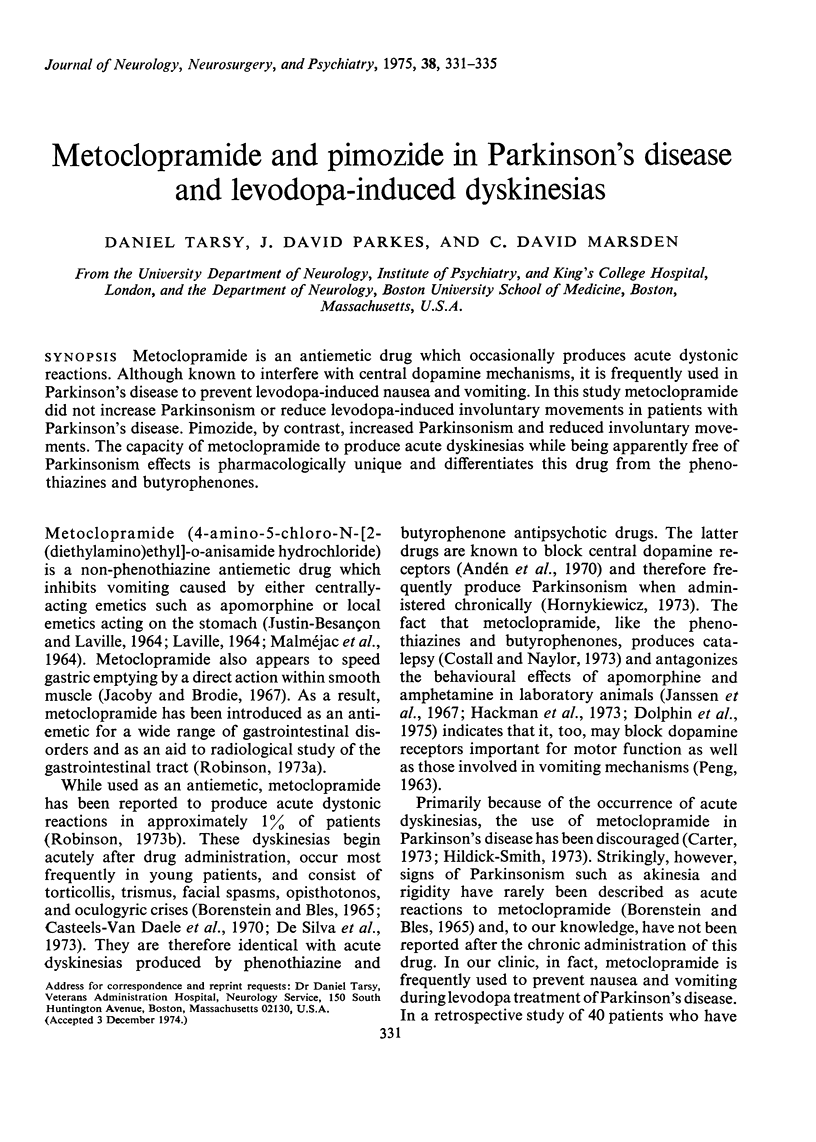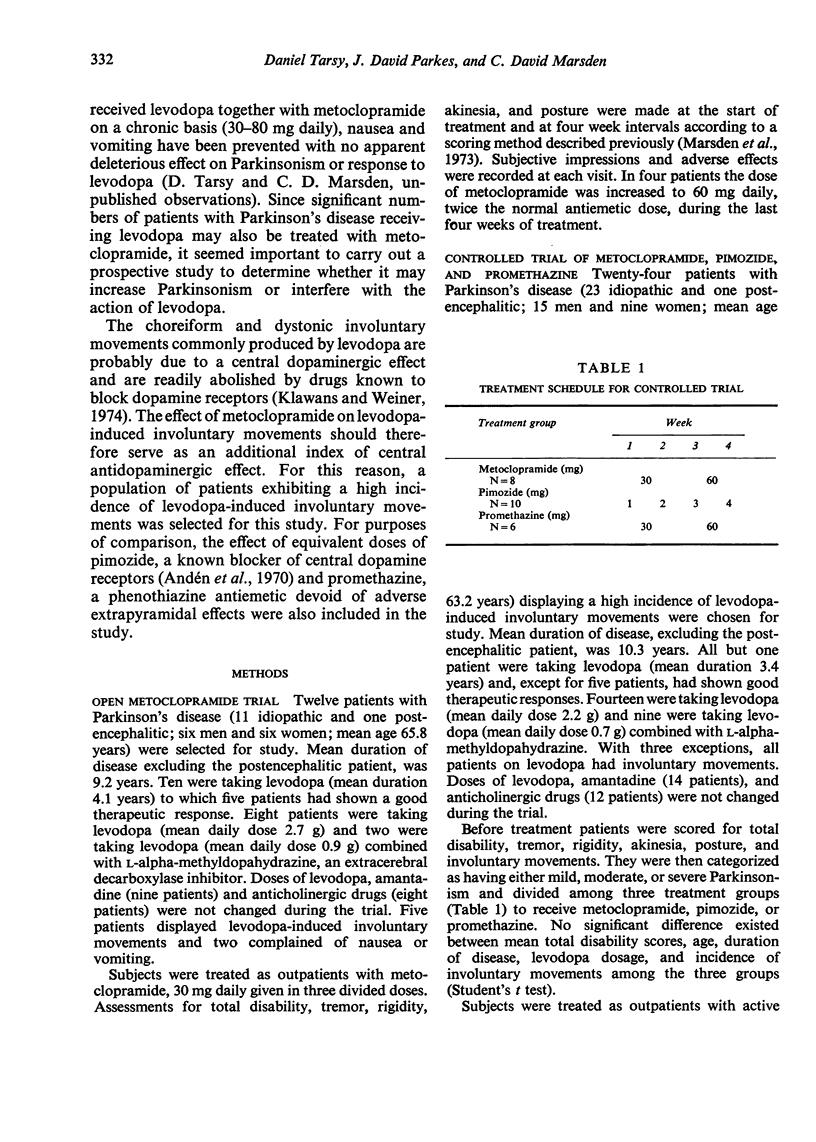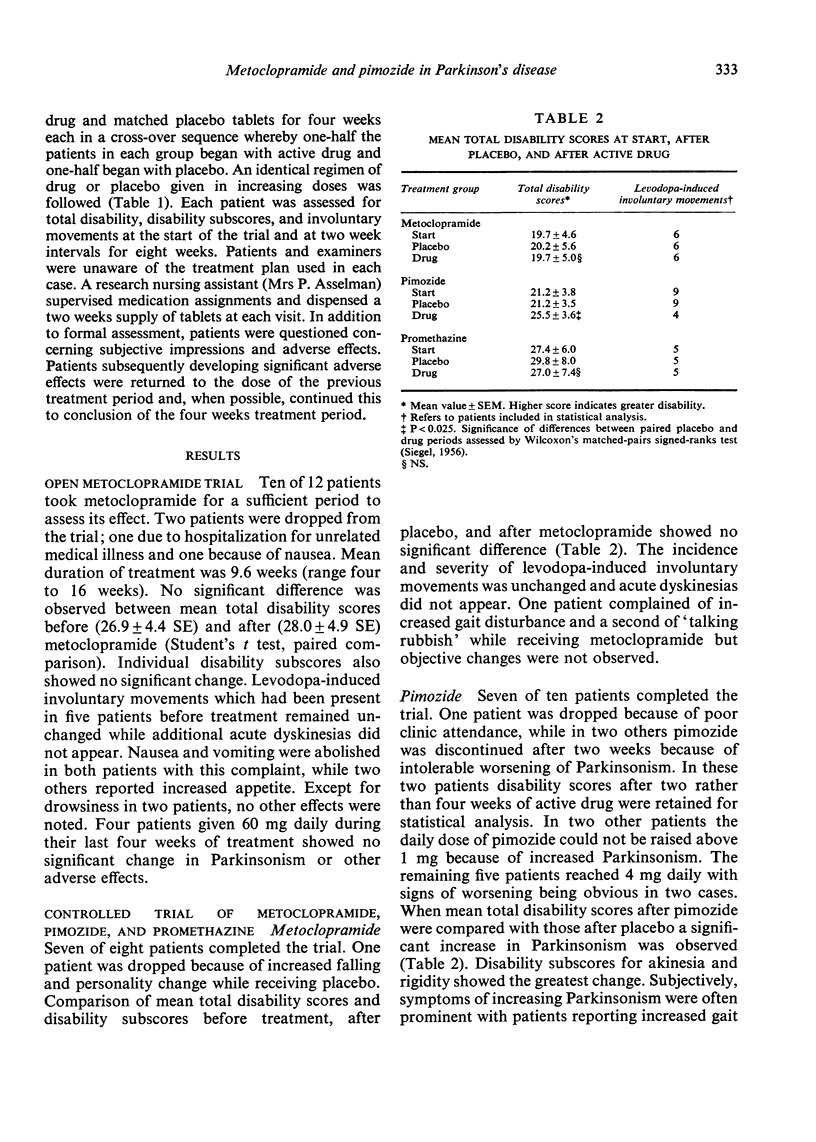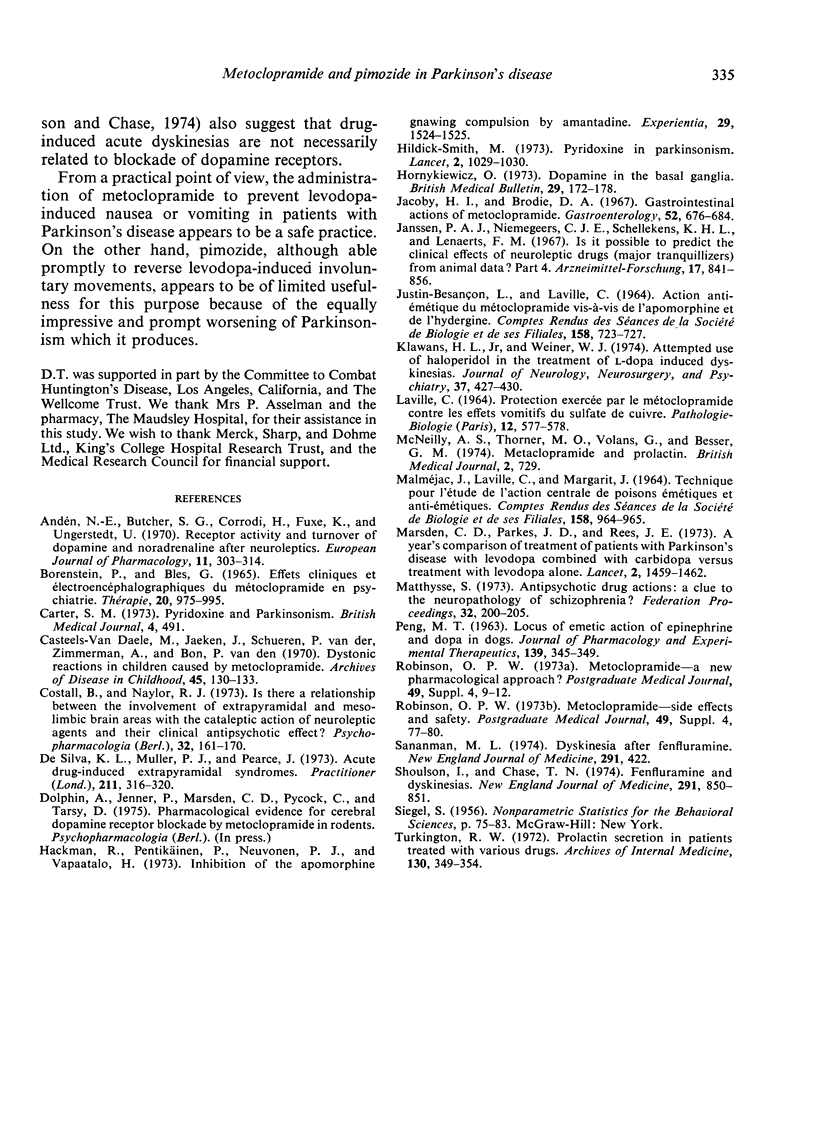Abstract
Metoclopramide is an antiemetic drug which occasionally produced acute dystonic reactions. Although known to interfere with central dopamine mechanisms, it is frequently used in Parkinson's disease to prevent levodopa-induced nausea and vomiting. In this study metoclopramide did not increase Parkinsonism or reduce levodopa-induced involuntary movements in patients with Parkinson's disease. Pimozide, by contrast, increased Parkinsonism and reduced involuntary movements. The capacity of metoclopramide to produce acute dyskinesias while being apparently free of Parkinsonism effects is pharmacologically unique and differentiates this drug from the phenothiazines and butyrophenones.
Full text
PDF




Selected References
These references are in PubMed. This may not be the complete list of references from this article.
- Andén N. E., Butcher S. G., Corrodi H., Fuxe K., Ungerstedt U. Receptor activity and turnover of dopamine and noradrenaline after neuroleptics. Eur J Pharmacol. 1970;11(3):303–314. doi: 10.1016/0014-2999(70)90006-3. [DOI] [PubMed] [Google Scholar]
- Borenstein P., Bles G. Effets cliniques et électroencéphalographiques du métoclopramide en psychiatrie. Therapie. 1965 Jul-Aug;20(4):975–995. [PubMed] [Google Scholar]
- Casteels-Van Daele M., Jaeken J., Van der Schueren P., Van den Bon P. Dystonic reactions in children caused by metoclopramide. Arch Dis Child. 1970 Feb;45(239):130–133. doi: 10.1136/adc.45.239.130. [DOI] [PMC free article] [PubMed] [Google Scholar]
- Costall B., Naylor R. J. Is there a relationship between the involvement of extrapyramidal and mesolimbic brain areas with the cataleptic action of neuroleptic agents and their clinical antipsychotic effect? Psychopharmacologia. 1973;32(2):161–170. doi: 10.1007/BF00428687. [DOI] [PubMed] [Google Scholar]
- De Silva K. L., Muller P. J., Pearce J. Acute drug-induced extrapyramidal syndromes. Practitioner. 1973 Sep;211(263):316–320. [PubMed] [Google Scholar]
- Hackman R., Pentikainen P., Neuvonen P. J., Vapaatalo H. Inhibition of the apomorphine gnawing compulsion by amantadine. Experientia. 1973 Dec;29(12):1524–1525. doi: 10.1007/BF01943894. [DOI] [PubMed] [Google Scholar]
- Hornykiewicz O. Dopamine in the basal ganglia. Its role and therapeutic implications (including the clinical use of L-DOPA). Br Med Bull. 1973 May;29(2):172–178. doi: 10.1093/oxfordjournals.bmb.a070990. [DOI] [PubMed] [Google Scholar]
- JUSTIN-BESANCON L., LAVILLE C. ACTION ANTI'EM'ETIQUE DU M'ETOCLOPRAMIDE VIS-'A-VIS DE L'APOMORPHINE ET DE L'HYDERGINE. C R Seances Soc Biol Fil. 1964;158:723–727. [PubMed] [Google Scholar]
- Jacoby H. I., Brodie D. A. Gastrointestinal actions of metoclopramide. An experimental study. Gastroenterology. 1967 Apr;52(4):676–684. [PubMed] [Google Scholar]
- Janssen P. A., Niemegeers C. J., Schellekens K. H., Lenaerts F. M. Is it possible to predict the clinical effects of neuroleptic drugs (major tranquillizers) from animal data? IV. An improved experimental design for measuring the inhibitory effects of neuroleptic drugs on amphetamine-or apomorphine-induced "Cheroing" and "agitation" in rats. Arzneimittelforschung. 1967 Jul;17(7):841–854. [PubMed] [Google Scholar]
- Klawans H. L., Jr, Weiner W. J. Attempted use of haloperidol in the treatment of L-dopa induced dyskinesias. J Neurol Neurosurg Psychiatry. 1974 Apr;37(4):427–430. doi: 10.1136/jnnp.37.4.427. [DOI] [PMC free article] [PubMed] [Google Scholar]
- LAVILLE C. PROTECTION EXERC'EE PAR LE M'ETOCLOPRAMIDE CONTRE LES EFFETS VOMITIFS DU SULFATE DE CUIVRE. Pathol Biol. 1964 May;12:577–578. [PubMed] [Google Scholar]
- MALMEJAC J., LAVILLE C., MARGARIT J. TECHNIQUE POUR L''ETUDE DE L'ACTION CENTRALE DE POISONS 'EM'ETIQUES ET ANTI-'EM'ETIQUES. C R Seances Soc Biol Fil. 1964;158:964–965. [PubMed] [Google Scholar]
- Marsden C. D., Parkes J. D., Rees J. E. A year's comparison of treatment of patients with parkinson's disease with levodopa combined with carbidopa versus treatment with levodopa alone. Lancet. 1973 Dec 29;2(7844):1459–1462. doi: 10.1016/s0140-6736(73)92729-3. [DOI] [PubMed] [Google Scholar]
- Matthysse S. Antipsychotic drug actions: a clue to the neuropathology of schizophrenia? Fed Proc. 1973 Feb;32(2):200–205. [PubMed] [Google Scholar]
- McNeilly A. S., Thorner M. O., Volans G., Besser G. M. Letter: Metaclopramide and prolactin. Br Med J. 1974 Jun 29;2(5921):729–729. doi: 10.1136/bmj.2.5921.729. [DOI] [PMC free article] [PubMed] [Google Scholar]
- Robinson O. P. Metoclopramide--side effects and safety. Postgrad Med J. 1973 Jul;49 (Suppl 4):suppl 4–4:80. [PubMed] [Google Scholar]
- Sananman M. L. Letter: Dyskinesia after fenfluramine. N Engl J Med. 1974 Aug 22;291(8):422–422. [PubMed] [Google Scholar]
- Shoulson I., Chase T. N. Letter: Fenfluramine and dyskinesias. N Engl J Med. 1974 Oct 17;291(16):850–851. doi: 10.1056/NEJM197410172911617. [DOI] [PubMed] [Google Scholar]
- Turkington R. W. Prolactin secretion in patients treated with various drugs: phenothiazines, tricyclic antidepressants, reserpine, and methyldopa. Arch Intern Med. 1972 Sep;130(3):349–354. [PubMed] [Google Scholar]


